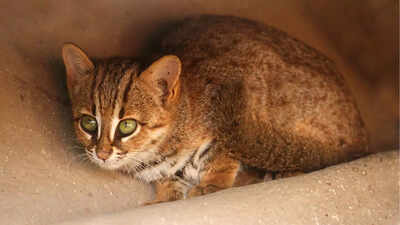
Wild cats are a diverse family of felines ranging from large predators like tigers to small, elusive species. Among them, the rusty-spotted cat stands out as the world’s smallest and tiniest wild predator that fascinates people from its characteristics.
Native to India and Sri Lanka, this tiny feline measures just 14 to 19 inches long and weighs only 2 to 3.5 pounds. Its gray fur is covered with distinctive rusty-colored spots. Despite its small size, the rusty-spotted cat is a skilled nocturnal hunter, feeding on rodents, birds, and insects. Shy and rarely seen, it prefers dense forests and grasslands, playing an important ecological role.
Rusty Spotted cat is the world’s smallest wild cat; know about its lifespan, size, and more
| Attribute | Details |
| Scientific Name | Prionailurus rubiginosus |
| Common Name | Rusty-spotted cat |
| Size | Body: 14–19 inches (35–48 cm); Tail: 7–10 inches (18–26 cm) |
| Weight | 2–3.5 pounds (1–1.6 kg) |
| Fur and Coloration | Soft, short fur; gray to tawny with rusty or reddish-brown spots |
| Physical Features | Rounded ears, large eyes, slender build |
| Taxonomy | Family: Felidae; Genus: Prionailurus; Related to leopard cat and fishing cat |
| Lifespan | Up to 10+ years in captivity; shorter in the wild |
Habitat of rusty spotted cat
The rusty-spotted cat primarily inhabits forests and grasslands in parts of India and Sri Lanka, with some populations recently confirmed in Nepal.
It prefers dense, moist forests, including tropical dry deciduous and evergreen forests, but can also be found in scrublands, rocky areas, and sometimes near human settlements. This cat is highly elusive and relies on thick vegetation or natural shelters like hollow logs and rock crevices for cover during the day.
Its range is patchy and limited, largely due to habitat loss and fragmentation caused by human activities.
Behaviour and lifestyle of rusty spotted cat
The rusty-spotted cat is nocturnal and solitary, meaning it is most active at night and prefers to live alone except during mating or when raising kittens. It is extremely shy and elusive, making sightings very rare. This small wild cat is a skilled hunter, preying on rodents, birds, insects, and small reptiles. It uses its agility and camouflage to stalk and catch prey quietly. During the day, it usually hides in dense undergrowth, hollow logs, or rocky shelters to avoid predators and disturbances.
The rusty-spotted cat marks its territory using scent glands, helping it communicate with other cats.
Reproduction of rusty spotted cat
The rusty-spotted cat is a solitary and territorial animal, coming together only to mate. Little is known about its exact breeding season, but like many small wild cats, it may breed year-round depending on environmental conditions. After a gestation period of about 65 to 70 days, the female gives birth to a litter of one to three kittens.
The mother cares for the young alone, keeping them hidden in dense vegetation or sheltered spots until they are old enough to hunt and survive independently.
The kittens grow quickly but remain with their mother for several months before dispersing to establish their own territories.
Ecological role of rusty spotted cat
The rusty-spotted cat plays an important role as a small predator in its ecosystem. By hunting rodents, birds, insects, and small reptiles, it helps control these populations, maintaining a balanced food web. This predation reduces crop damage caused by rodents and helps keep insect populations in check, indirectly benefiting agriculture and human communities nearby. As a prey species for larger predators, it also contributes to the broader food chain.
Despite its tiny size, the rusty-spotted cat is a vital part of its habitat’s biodiversity and ecosystem health.
Threats to rusty spotted cat
Habitat Loss: Conversion of forests into agricultural land and urban development.
Human-Wildlife Conflict: Persecution due to livestock predation.
Road Mortality: Accidental deaths from vehicles.
Illegal Trade: Poaching for pelts and as exotic pets.
Conservation efforts for rusty spotted cat
Monitoring : Installation of camera traps in key habitats, such as Keoladeo National Park, to study behavior and population dynamics.
Habitat Protection: Conservation of forested areas and establishment of wildlife corridors.
Community Engagement: Raising awareness among local communities to reduce human-wildlife conflict.
Captive Breeding: Initiatives like the one at Sanjay Gandhi National Park aim to increase population numbers.
Also read: Explore 5 land creatures on Earth that swim better than you imagine












 English (US) ·
English (US) ·